Vue实现组件间通信的几种方式(多种场景)
作者:前端菜小白leo
以下是我在开发中用到过的vue组件之间的通信方式,不同的场景使用不同的方式,基本满足所有开发场景中的通信需求,从最简单的事例着手,讲述如何使用,话不多说直接开始,满满的干货,建议看完。
1、Props
父 >>> 子 (Props)
一个组件里面引入另外一个组件,此时构成了一种“父子关系”,当前组件为“父”,引入的组件为“子”,如当前组件(父),在父组件中通过 “:message” 向子组件通信。
<template>
<div class="parent-box">
<div>
<div>我是父页面</div>
<div>{{message}}</div>
</div>
<children :message="toChildrenMsg"></children>
</div>
</template>
<script>
import Children from './Children.vue' //当前页引入子组件
export default {
name:"Parent",
components:{
Children
},
data(){
return {
message:'我是父页面的内容',
toChildrenMsg:'从父页面传过到子页面的内容'
}
}
}
</script>
在子组件通过props进行接收,注意子组件props里面接收的对象名称必须与父组件中在子组件绑定的名称一致,当前例子为“message”,可以在组件return中this.的方式使用props里面的值。
<template>
<div class="children-box">
<div>
<div>我是子页面</div>
<div>{{message}}</div>
</div>
</div>
</template>
<script>
export default {
name:"Children",
props:{
message:{
type:String, //类型判断
default:'' //默认值
}
}
}
</script>
子组件接收到父组件传过来的内容,实现效果如下图所示:
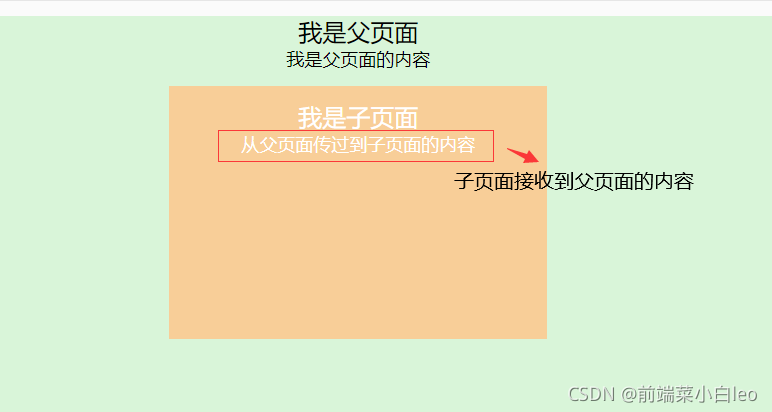
子 >>> 父 ($emit)
在子组件中通过this.$emit()方法向父组件通信,如下,点击触发事件,执行this.$emit('fromChildMethod'),触发父组件的fromChildMethod方法。
<template>
<div class="children-box">
<div>
<div>我是子页面</div>
<div>{{message}}</div>
<div><span @click="toParentMethod">点击触发父页面事件</span></div>
</div>
</div>
</template>
<script>
export default {
name:"Children",
props:{
message:{
type:String,
default:''
}
},
methods:{
toParentMethod(){
this.$emit('fromChildMethod')
}
}
}
</script>
在父组件的子组件上绑定fromChildMethod方法,对该方法进行监听,当该方法触发时,执行父组件中相应的方法fromChild。
<template>
<div class="parent-box">
<div>
<div>我是父页面</div>
<div style="font-size:12px;">{{message}}</div>
<div style="font-size:12px;color:red">{{fromChildMsg}}</div>
</div>
<children :message="toChildrenMsg" @fromChildMethod="fromChild"></children>
</div>
</template>
<script>
import Children from './Children.vue'
export default {
name:"Parent",
components:{
Children
},
data(){
return {
message:'我是父页面的内容',
toChildrenMsg:'从父页面传过到子页面的内容',
fromChildMsg:''
}
},
methods:{
fromChild(){
this.fromChildMsg = '子页面触发的方法' //监听到子组件触发的方法,显示该内容
}
}
}
</script>
当点击子组件的对应的span,触发方法,向父组件进行通知。
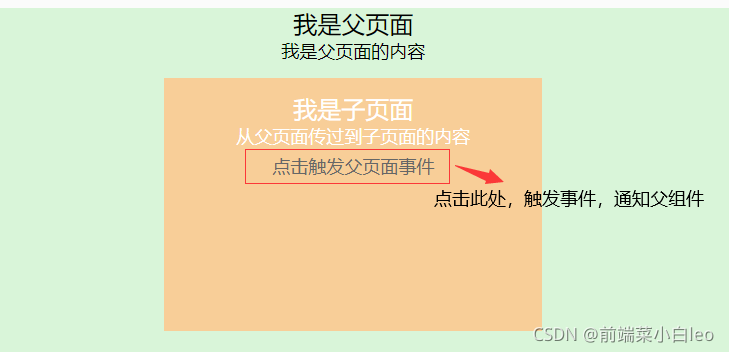

小结:父传子,props;子传父,this.$emit();触发、监听名称须一致。
2、Bus事件总线
真实的场景中,组件不仅仅是“父子”关系,还有“兄弟”关系跟跨层级组件等等。这时候props跟$emit可能就不太适用了,这时候它出现了,那就是Bus(事件总线),父子组件同样适用。
Bus之触发$emit、监听$on、关闭$off,主要用到的就是$emit跟$on。
先在项目中新建一个文件夹bus,里面有个index.js文件,创建一个新的Vue实例,然后导出模块。
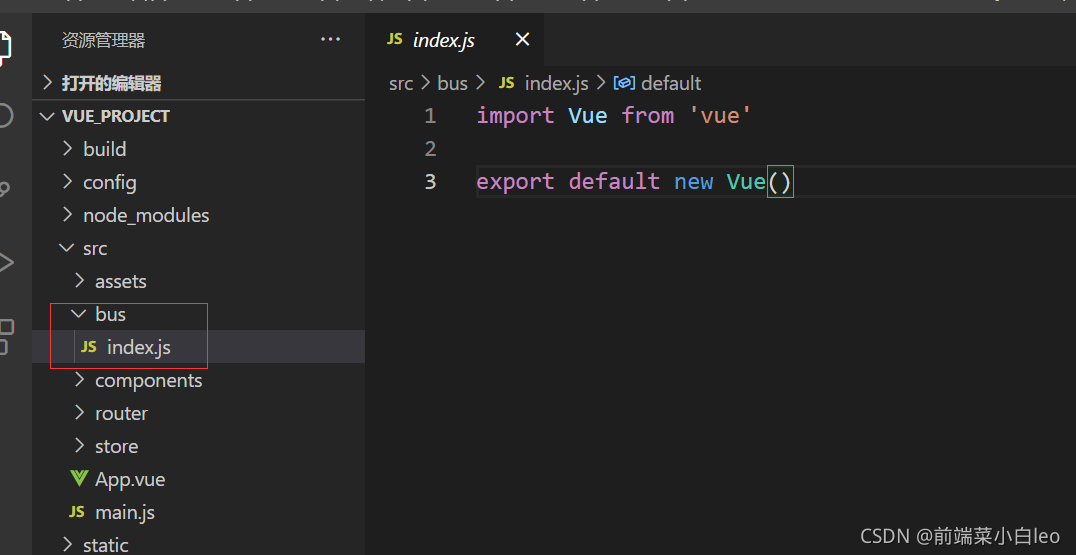
接下来import这个新的Vue实例,也就是bus,常用的两种导入方式,一种是全局导入,另外一种是局部导入(需每个组件都导入一次)。以下为全局导入,在main.js里面将该bus作为当前Vue实例的原型方法,能直接在各组件里面通过this.bus的方式调用。
import Vue from 'vue'
import App from './App'
import bus from './bus/index'
Vue.prototype.bus = bus
new Vue({
el: '#app',
components: { App },
template: '<App/>'
})
下面展示实现bus通信过程,场景为父子,同样的,兄弟、跨层级用法与其类似:
Parent组件中向Children组件通信,通过this.bus.$emit()触发
<template>
<div class="parent-box">
<div>
<div>我是父页面</div>
<div @click="toChildBus"><span>向子组件通信</span></div>
</div>
<children></children>
</div>
</template>
<script>
import Children from './Children.vue'
export default {
name:"Parent",
components:{
Children
},
methods:{
toChildBus(){
let val = '父组件向子组件通信'
this.bus.$emit('toChild',val) //val为传过去的值,非必传
}
}
}
</script>
Children组件监听Parent组件触发的事件(在mounted阶段进行绑定监听),注意事件名称要一致,通过this.bus.$on()监听,当总线中监听到触发该方法,拿到传过来的值(也可以在里面执行自定义方法)。
<template>
<div class="children-box">
<div>
<div>我是子页面</div>
<div style="font-size:12px;color:blue;">{{fromParentMsg}}</div>
</div>
</div>
</template>
<script>
export default {
name:"Children",
data(){
return {
fromParentMsg:''
}
},
mounted(){
this.bus.$off('toChild')
this.bus.$on('toChild',val=>{
this.fromParentMsg = val //此处为复制操作,也可在里面执行相应的方法
})
}
}
</script>
效果图:
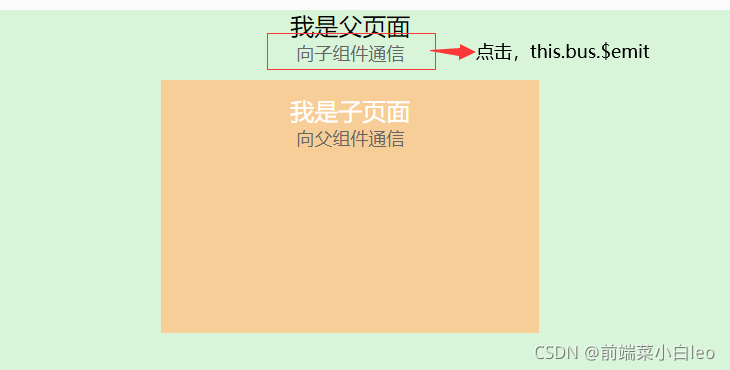
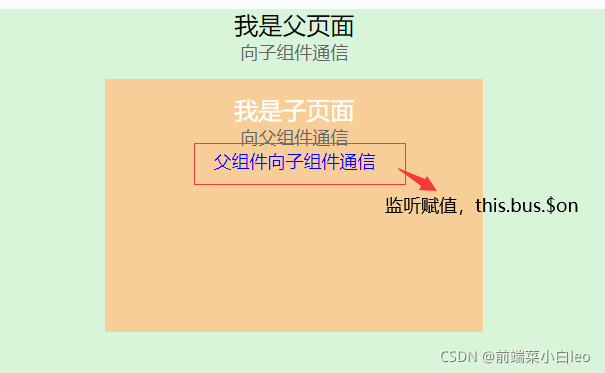
总结:父子,兄弟,跨级(祖孙等)通信写法相同,就不一一举例了,都是通过this.bus.$emit()触发,通过this.bus.$on()监听,执行相应的操作,切记:触发、监听名称必须相同!
3、Vuex状态管理库
Vuex相当于一个仓库,你可以往仓库里面放一些东西,保持存进去的时的状态,可以修改,也可以在需要的时候取出,是一个全局状态。本次只讲如何使用vuex进行通信,不深究其原理。
安装vuex
npm install vuex --save
这里我新建一个文件夹,名称为store,里面有一个index.js文件,创建一个Vuex.Store实例,然后导出这个实例,从图中可以明确看出store的大致结构及其要素,具体不展开讲,关于vuex的相关文章数不胜数,可以自行去了解,这里主要讲大致用法。
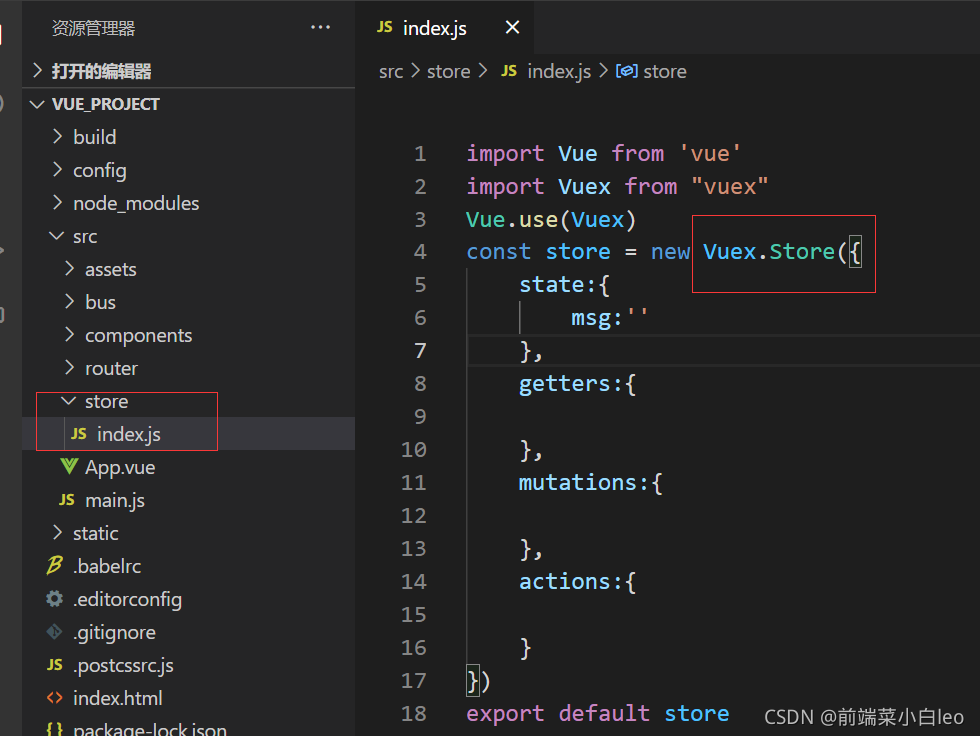
在mian.js全局引入,之后就可以直接使用了。
import Vue from 'vue'
import App from './App'
import router from './router'
import bus from './bus/index'
import store from './store/index'
Vue.config.productionTip = false
Vue.prototype.bus = bus
new Vue({
el: '#app',
router,
store,
components: { App },
template: '<App/>'
})
方式一,this.$store.state.xxx,直接对state进行操作,在一个组件mounted阶段将值存如store中,当然也可在你想在的方法中进行操作。
<template>
<div class="parent-box">
<div>
<div>我是父页面</div>
</div>
<children></children>
</div>
</template>
<script>
import Children from './Children.vue'
export default {
name:"Parent",
components:{
Children
},
data(){
return {
fromChildMsg:''
}
}
mounted(){
this.$store.state.msg = '父组件存入' //在此处通过方式一存起来
}
}
</script>
其他组件从store中取出,当然同样也可以进行修改。
<template>
<div class="children-box">
<div>
<div>我是子页面</div>
<div @click="fromStore"><span>从store里面取</span></div>
<div>{{fromStoreMsg}}</div>
</div>
</div>
</template>
<script>
export default {
name:"Children",
data(){
return {
fromStoreMsg:''
}
},
methods:{
fromStore(){
this.fromStoreMsg = this.$store.state.msg
}
}
}
</script>
效果图:
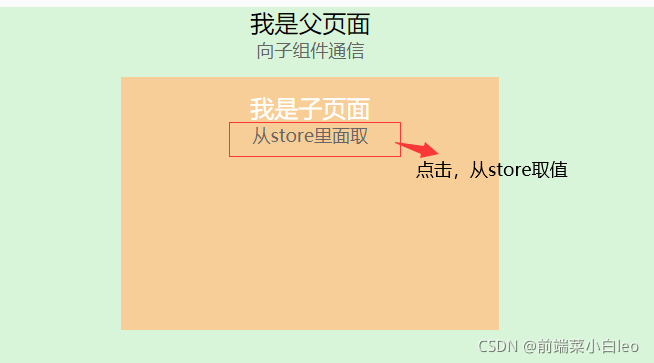

方式二,通过this.$store.getters.xxx、mapGetters进行取出。
// store/index.js
getters:{
getMsg:state=>{
return state.msg
}
},
//组件中取
this.$store.getters.getMsg
//也可以用mapGetters的方式
import { mapGetters } from 'vuex'
computed: {
...mapGetters(['getMsg'])
},
对store存入数据该可以用mutations、actions(可异步)进行存入,具体就不展开了,有兴趣可以自己去深究。
4、Router
可以通过动态路由、路由跳转方式进行传值,如this.$router.push({path:'xxx',query:{value:'xxx'}}),在跳转的时候顺便传值,通过this.$route.params.value和this.$route.query.value获取到传过来的参数。该方式有局限性,只能在相互跳转的组件通信取值,且直接在跳转之后的页面进行刷新取不到值,视情况而用。
5、缓存
sessionStorage、localStorage、cookie
多个组件之间的通信除了可以用bus、store之外,还比较一种常用的方式--缓存,在同一个窗口不关闭的情况下,该窗口下的其他组件都可以取到缓存中已经存好的值,利用sessionStorage.setItem(key,value)、localStorage.setItem(key,value)等将值存起来,其他组件可以通过sessionStorage.getItem(key)、localStorage.getItem(key)等方式拿到,多个页面共享缓存数据,刷新页面数据不会销毁,可以用sessionStorage.removeItem(key)、localStorage.removeItem(key)的方式将缓存移除,可用场景还是比较多的。
总结:大致介绍vue组件中几种常用的通信、传值方式,考虑不同的场景使用不同的方式,提高开发效率,减少bug的产生。
到此这篇关于Vue实现组件间通信的几种方式(多种场景)的文章就介绍到这了,更多相关Vue 组件通信内容请搜索脚本之家以前的文章或继续浏览下面的相关文章希望大家以后多多支持脚本之家!
